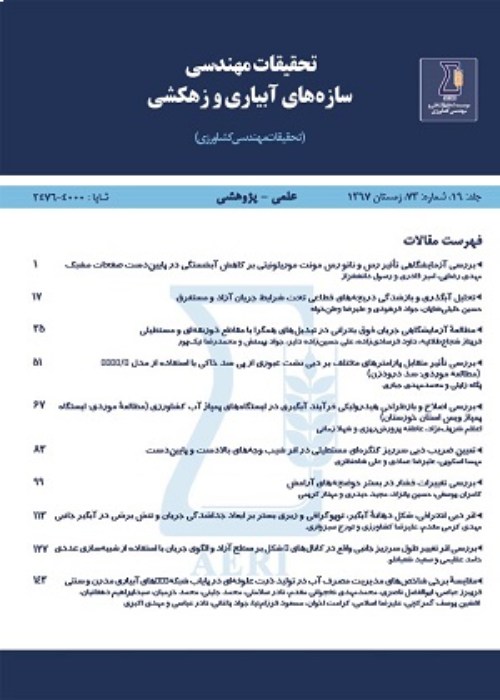Evaluation and improvement of water management of irrigation networks under water scarce condition(Case study: Eastern Aghili secondary canal)
The experience of irrigation networks in recent years shows that traditional operation methods are not able to implement proper water delivery in water scarce periods and enhancing is unavoidable. In many cases, delivered water does not match water requirement, and it causes decreasing water productivity and farmer’s dissatisfaction. (Sadeghi and Monem, 2014)Irrigation delivery under these conditions is a complex process. Optimization techniques have limitations in the above situations (Santhi and Pundarikanthan., 1999)Monem et al. showed that using hydrodynamic model and unsteady flow analysis is a suitable approach to determine appropriate operation, and performance improvement of irrigation networks under harsh circumstances. (Monem, et al., 2005)In this paper, the main goal is improving the operational distribution management in irrigation networks in water scarce situation. At the first step, the water delivery and distribution status in Eastern Aghili secondary canal is evaluated for full discharge, 20% and 40% water scarce situation (as scenario 0). At the second step, four management scenarios have been defined, and are simulated to manage water scarcity.
Aghili Irrigation Network is located in Gotvand irrigation area in Khuzestan. In present study, the East Aghili secondary canal is selected. This canal is a concrete lined canal having trapezoidal cross section with side slope of 1:1, and length of 16.215 km. The bed width of the canal in the first half is 1.5 meters and for the second half is 1 meter. For clear presentation and discussion of the results, the 9 km of the canal which has 13 outlets is simulated. Simulations are done using ICSS hydrodynamic model. The ICSS model simulates steady flow by solving gradually varied flow equations proposed by Henderson, and unsteady flow by solving St.Venant equations proposed by Sterlekof. It can simulate different structures with the wide range of operations. Performance indicators proposed by Molden and Gates (1990) are used for evaluation of the scenarios. Delivery efficiency, adequacy, and equity indicators, are calculated and discussed for scenarios. In this paper four scenarios are defined for three irrigation level of 100%, 80% and 60% of the required discharge for 24 hour delivery period. The scenarios are:1. The volume of water delivered to all outlets have been decreased proportionally to the shortage of water at the head of canal. The operation of structures are done at the same time. (Scenario 1)2. The second scenario is defined by a Prioritization based on cultivation pattern. Outlets number 3, 6, 8, 10, 11, are considered to have priority for water delivery. So, these outlets receive full discharge, and water shortage is distributed to other outlets (Scenario 2)3. In this scenario the outlets are divided into two groups, which in both groups, sum of the required discharge is equal. In the first 12 hours the first group (outlet numbers 1 to 5) receive their full required discharge, and the second group receive decreased discharge proportional to remaining water left in the canal. At the second 12 hours, the water distribution and corresponding operation is done reversely. (Scenario 3)4. In this scenario, also, the outlets are divided into two groups, which in both groups, sum of the required discharge is equal. In the first 12 hours the first group (outlets number 1 to 5) are closed, and water is delivered to the second group of outlets. At the second 12 hours, the water delivery and corresponding operation is done reversely. (Scenario 4).
The result of zero scenario shows that under 20 percent water scarcity, the Adequacy Index is less than 90% for five outlets, and 38% outlets have medium adequacy. The Equity Index is 0.07. For 40 percent water scarcity, 9 outlets (70%) have a medium and poor adequacy, and the equity index is 0.13. This results show that in water scarce situation, not only the adequacy is decreased, but also the equity of water distribution is harmed.After the use of four defined scenarios, the results indicate acceptable improvement in all scenarios, under both 20 % and 40 % water scarcity. Under 20% water scarcity the first scenario, and for 40% water scarcity, the fourth scenario has the highest performance indices. For 20% scarcity, the priority of the scenarios are, scenario no. 1, 4, 3, and 2. For 40% scarcity the priorities are, scenario no. 4, 3, 2, and 1.
Water shortage without appropriate management actions, will cause poor performance not only from adequacy point of view, but also from equity aspect. According to the results, all proposed management actions, have acceptable effect in water delivery improvement under both 20% and 40% water scarcity with little differences. For selection of the scenarios in addition to hydraulic performance, operational efforts and social acceptance of different scenarios should be considered as well.
- حق عضویت دریافتی صرف حمایت از نشریات عضو و نگهداری، تکمیل و توسعه مگیران میشود.
- پرداخت حق اشتراک و دانلود مقالات اجازه بازنشر آن در سایر رسانههای چاپی و دیجیتال را به کاربر نمیدهد.



